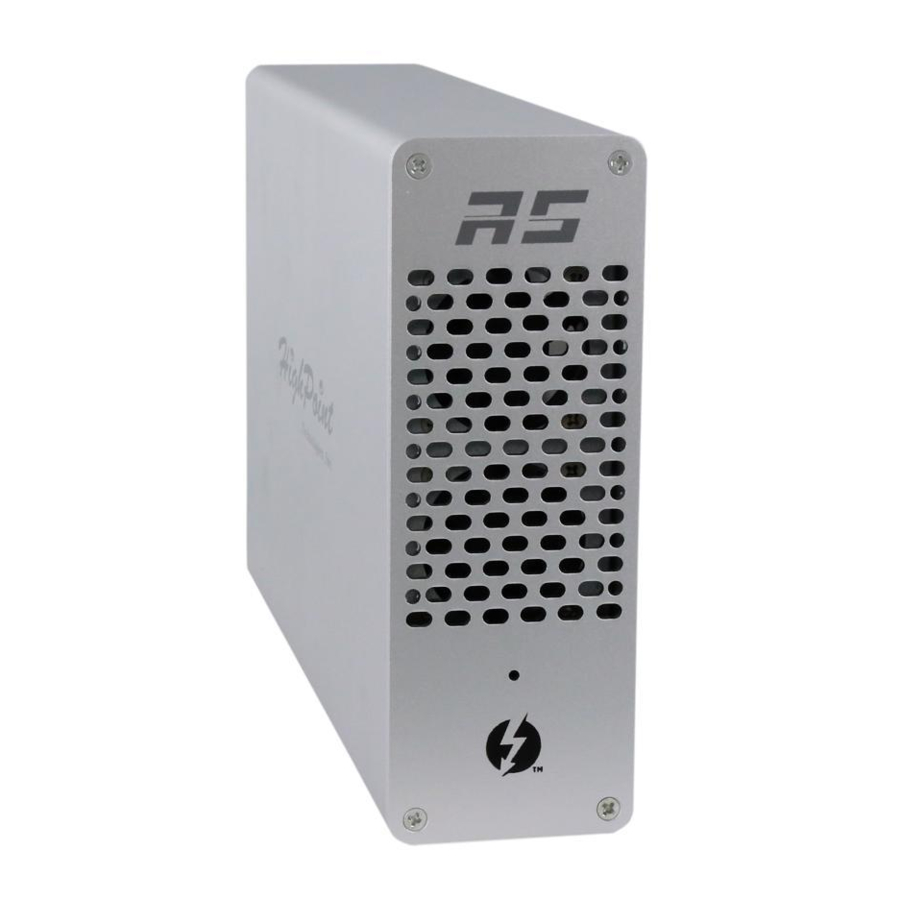
Table of Contents
Advertisement
Quick Links
Advertisement
Table of Contents

Summary of Contents for HighPoint RS6661A-NVMe
- Page 1 RS6661A-NVMe Thunderbolt 3 to NVMe RAID Adapter User Guide V1.00...
-
Page 2: Table Of Contents
Kit Contents .........................3 System Requirements ....................4 RocketStor 6661A Hardware ..................4 SSD7101A-1 Hardware ....................5 Setting up the RS6661A-NVMe for a Windows operating system ......9 Setting up the RS6661A-NVMe for a Mac system...........12 Using the HighPoint NVMe Manager ..............12 Customer Support .....................19... -
Page 3: Highpoint Rocketstor 6661A-Nvme
HighPoint RocketStor 6661A-NVMe The RocketStor 6661A-NVMe allows you to quickly add an NVMe RAID controller to your Thunderbolt™ 3 capable computing platform. The ultra slim, lightweight design is ideal for compact form-factor workstation and portable computers and is fully compatible with Mac platforms. -
Page 4: System Requirements
System Requirements PC Requirements • Windows 10 or later • macOS 10.12 or later For SSD compatibility list, please refer to the below link: SSD7100 Compatibility list RocketStor 6661A Hardware... -
Page 5: Ssd7101A-1 Hardware
SSD7101A-1 Hardware Front View NVMe Drive Installation: Step 1. Unscrew the two Thumbscrew in the back of the RS6661A Step 2. Take out the SSD7101A-1 of the RS6661A Step 3. On the rear of the SSD7101A-1, remove the six screws that secure the unit’s front panel to the PCB. - Page 6 Step 4. After removing the screws, carefully remove the front panel from the SSD7101A-1. Step 5. These 4 screws are used to install the NVMe SSD’s. Step 6. The SSDs should be installed from top to bottom. To begin, remove the top screw.
- Page 7 Step 7. Gently insert the SSD into the slot. Step 8. Refasten the screw to secure the SSD. Repeat Steps 3 to 5 to install the remaining SSDs.
- Page 8 Step 9. Replace the front panel after installing all SSDs Step 10. On the rear of the SSD7101A-1, refasten the 6 screws that were removed in step 1. Step 11. Plug in the SSD7101A-1 into the RS6661A slot and close the unit with the two thumb screws.
-
Page 9: Setting Up The Rs6661A-Nvme For A Windows Operating System
Step 13. Connect the RocketStor 6661A-NVMe to the host system using a Thunderbolt™ cable. Setting up the RS6661A-NVMe for a Windows operating system Verifying Installation After booting Windows, open Device Manager, and expand Disk drives. The installed NVMe Samsung SSD 960 should be displayed:... - Page 10 Driver Installation Download the Windows driver package from the HighPoint website: http://highpoint-tech.com/USA_new/series-rs6661a-nvme-download.h Once downloaded, locate the folder you downloaded the driver to. Extract the driver package and double click the setup.exe file to start the Driver Setup Wizard. Follow the wizard and reboot system to complete the driver...
- Page 11 Rebooting. A RocketNVME RAID Controller entry should be displayed under Storage Controllers: Installing the HighPoint NVMe Manager software The HighPoint NVMe Manager is used to configure and monitor the SSD7101A-1. Download the HighPoint NVMe Manager Software package from the HighPoint website: http://highpoint-tech.com/USA_new/series-rs6661a-nvme-download.htm...
-
Page 12: Setting Up The Rs6661A-Nvme For A Mac System
Starting the HighPoint NVMe Manager Double click the Desktop ICON to start the Web browser. It will automatically log-in to the HighPoint NVMe Manager using the default password. The password can be set after the first log-in. To change the password, select Setting>Security from the menu bar (see page 15 for more... - Page 13 Verify the SSD7101A-1 Status The Manage Tab will display the status of the installed SSD7101A-1. The Virtual Disk is listed under Logic Device Information. The individual M.2 SSDs are listed under Physical Device Information. Manage the RAID disk The SSD7101A-1 only supports one RAID disk, and NVMe Manager will automatically configure this RAID disk after the software has been installed.
- Page 14 To delete an existing RAID disk: Under Logical Device Information, click the Maintenance link located to the right of the Status column. Click the Delete button from the pop-up Array Information Window: Warning: Deleting the RAID disk will destroy all data on the existing RAID array. Please make sure to back up important data before proceeding.
- Page 15 To create a new RAID disk: Click the Create Array link from the Manage page: Review the array settings and confirm RAID creation. The SSD7101A-1 supports variable RAID Block Sizes from 16K to 1024K. You may adjust the RAID Block size from the Create Array page.
- Page 16 Product Information and Settings The Setting page includes Product Information, Email notification and Security settings. Product Information: This section reports the SSD7101A-1’s PCI Bus information and PCIe Link status. Email Notification: This feature allows you to configure email notification. You can instruct NVMe Manager to send all, or specific Event Log notifications to an Email address of your choice.
- Page 17 Event log All NVMe Manager operations and disk status updates will be recorded to the Event log. The Event log can be downloaded and saved to a file by clicking the Download button. The Clear button can be used to delete all entries and reset the event log. Warning: We recommend downloading and saving a copy of the current Event Log before using the Clear option.
- Page 18 SHI (Storage Health Inspector) The SHI page will display S.M.A.R.T. data for each individual M.2 SSD. Click the Detail link to the right of each SSD to view the corresponding S.M.A.R.T. attributes. The SSD’s TBW (Total Bytes Written) information may help you review and track the SSD’s life cycle.
-
Page 19: Customer Support
Customer Support If you encounter any problems while utilizing the RS6661A-NVMe have any questions about this or any other HighPoint Technologies, Inc. product, feel free to contact our Customer Support Department. Web Support: http://www.highpoint-tech.com/websupport/ HighPoint Technologies, Inc. websites: http://www.highpoint-tech.com © Copyright 2018 HighPoint Technologies, Inc. All rights reserved.















Need help?
Do you have a question about the RS6661A-NVMe and is the answer not in the manual?
Questions and answers